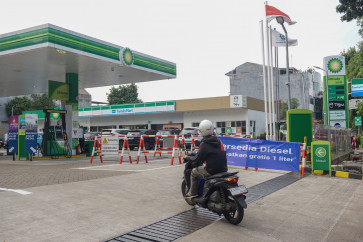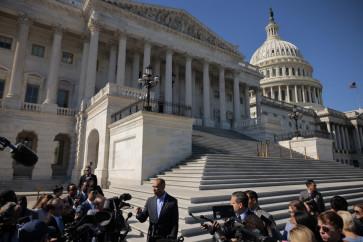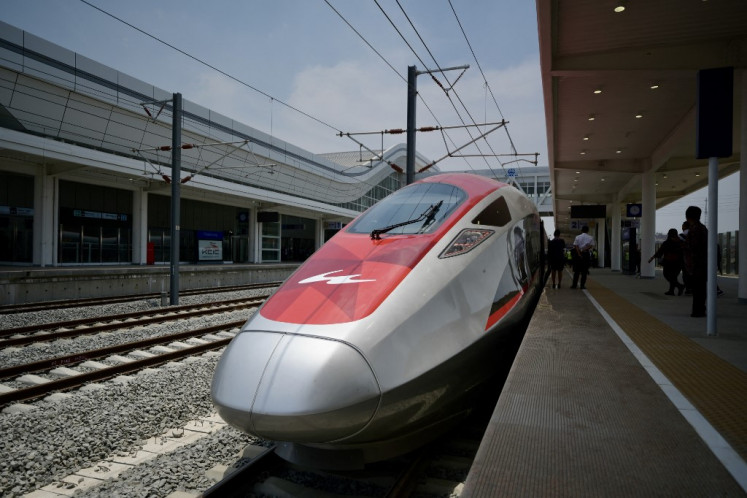Popular Reads
Top Results
Can't find what you're looking for?
View all search resultsPopular Reads
Top Results
Can't find what you're looking for?
View all search resultsBogor city to limit ‘angkot’ numbers, plan tram system
Besides being known as “the city of rain”, Bogor in West Java is also notorious as the “city of 1 million angkot [public minivan]”, thanks to their ubiquitous presence across the city
Change text size
Gift Premium Articles
to Anyone
B
esides being known as “the city of rain”, Bogor in West Java is also notorious as the “city of 1 million angkot [public minivan]”, thanks to their ubiquitous presence across the city. However, the municipal administration aims to steer the city in another direction with plans in store to regulate the unwieldy angkot as part of a strategy to improve transportation management.
Although not exactly 1 million in number, the Bogor administration has recorded that more than 6,400 angkot roam the streets of the 118.5-square-kilometer city. Not all fall under the administration’s authority as only 2,400 have acquired operating permits from the Bogor administration, with the rest coming from the neighboring Bogor regency.
Bogor Mayor Bima Arya Sugiarto recently said that in the first phase of the plan, the city aimed to reduce the number of angkot operating in the city center, particularly around the famous Bogor Botanical Garden, a popular tourist destination.
Moreover, the city will also impose age restrictions on public transportation vehicles and remap angkot routes. Bima said his administration was firm in its decision to not extend licenses for 800 angkot aged above 20 years by the end of this year.
Under the plan, his administration expects to reduce the number of angkot operating in the city center to 1,600.
“By 2022, angkot will disappear. They will go naturally,” he said on Thursday as quoted by kompas.com.
Bima said his office had also designed a scheme to limit the influx of angkot into the city.
He called on the West Java administration to support his plan by providing bus terminals at the city’s outskirts.
“Around 4,000 angkot enter Bogor city from [Bogor] regency. I hope the West Java provincial administration can be firm about this. Angkot from the regency outnumber angkot from Bogor city itself,” Bima said.
He also said the city was considering a plan to develop a tram system to provide more public transportation options for residents and visitors. The administration is still discussing studies for the tram.
“By 2022, the angkot will disappear. They will go naturally.”
The plan has sparked debate among the public, with some people believing the rail service will replace angkot.
However, Bima has refuted this assumption, arguing that the tram would instead complement the city center’s public transportation services.
“Don’t get me wrong. The tram will not alienate angkot. It will complement [angkot] instead.”
Urban and spatial planning lecturer from Bogor-based Pakuan University’s school of engineering Janthy Hidayat told The Jakarta Post on Friday that angkot were still needed by Bogor residents. However, he also acknowledged there was an urgent need for better regulations to maintain road orderliness.
Angkot driver Sumanta said he had no problem with the mayor’s plan to set a maximum age limit for angkot. Sumanta drives an angkot on route 07 that connects Ciparigi and Merdeka.
“I’m just a driver. If the mayor implements such a policy, only my fellow angkot drivers and I will feel the impact. If I have to retire from being an angkot driver, I could just find another job,” the 54-year-old said.
He also said the administration needed to curb the number angkot coming from Bogor regency. Sumanta suggested that instead of entering the city, angkot from Bogor regency could stop at the border. From there, passengers could take angkot that originate from Bogor city to the city center.
“For example, angkot that serve route 08, which connects Cibinong and Pasar Anyar, could drop their passengers in Ciluar. From there we [Bogor city angkot] could take the passengers to Pasar Anyar,” he said.
Regular angkot passenger Siti Nurdiana Fadilah, 18, echoed Sumanta views, saying that banning angkot from Bogor regency would be beneficial considering their large numbers.
“With less angkot from Bogor regency, Bogor city can reduce air pollution and alleviate traffic congestion,” she said.
The aforementioned measures follow an angkot conversion plan launched in 2018, through which the city sought to replace older vehicles with modern angkot. Dubbed the 3:2 program, the city aimed to replace every three conventional angkot with two modern angkot.
The modern angkot are equipped with air conditioning, CCTV cameras, Wi-Fi, USB ports and a cashless payment system.
The modern angkot currently operate on the Trans Pakuan Koridor (TPK) 4 route from Ciwaringin to Ciawi.
However, due to opposition from some angkot drivers, the program was suspended. The Bogor Transportation Agency is currently conducting an evaluation of the program before it is relaunched. (vla)










